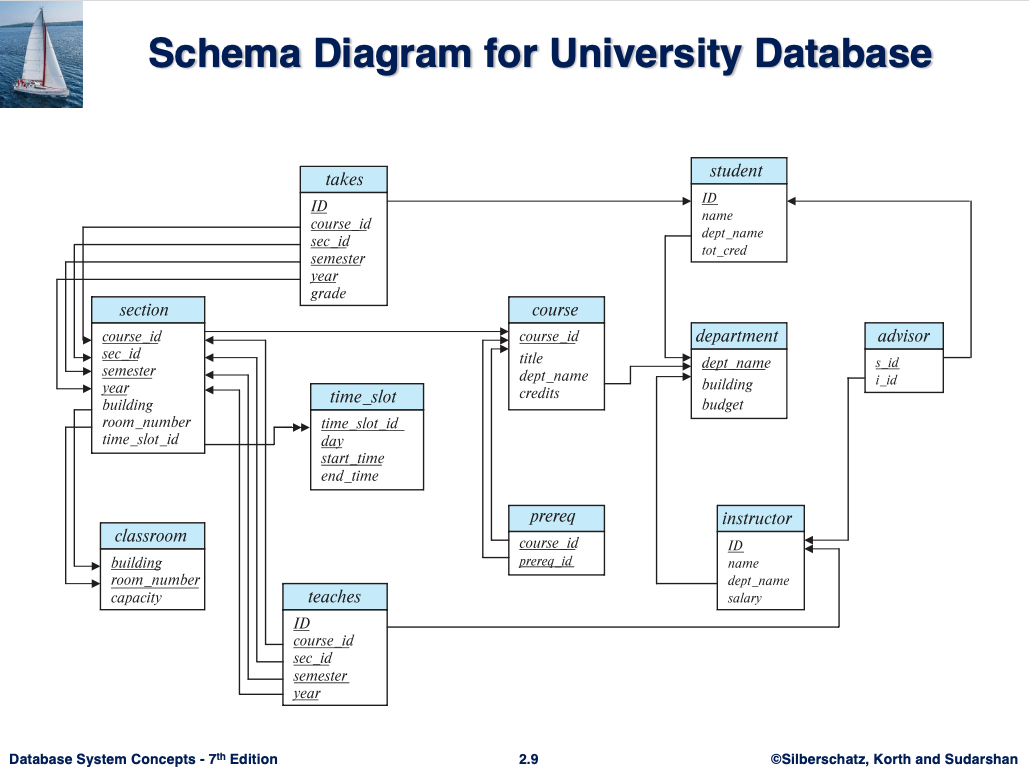Advanced SQL Practice Problems
Consider this schema from the textbook for a university database:

Write the following queries in SQL, using this schema. You can test your answers at https://www.db-book.com/db7/university-lab-dir/sqljs.html. The expected output is given for each query when run on large-university.db (download this file and run SQLite locally via sqlite3 large-university.db or upload to the browser-based version).
- Find the names of those departments whose budget is higher than that of Astronomy. List them in alphabetic order.1
dept_name Athletics Biology Cybernetics Finance History Math Physics Psychology
- Display a list of all instructors, showing each instructor's ID and the number of sections taught. Make sure to show the number of sections as 0 for instructors who have not taught any section.2
ID number_of_sections 16807 0 31955 0 35579 0 37687 0 4034 0 50885 0 52647 0 57180 0 58558 0 59795 0 63395 0 64871 0 72553 0 74426 0 78699 0 79653 0 95030 0 96895 0 97302 0 15347 1 25946 1 4233 1 42782 1 48507 1 48570 1 50330 1 65931 1 73623 1 80759 1 90376 1 90643 1 14365 2 28097 2 28400 2 3335 2 63287 2 81991 2 19368 3 34175 3 41930 3 3199 4 43779 4 95709 4 36897 5 74420 6 77346 6 79081 6 99052 9 6569 10 22591 13
- For each student who has retaken a course at least twice (i.e., the student has taken the course at least three times), show the course ID and the student's ID. Please display your results in order of course ID and do not display duplicate rows.3
course_id ID 362 16480 362 16969 362 27236 362 39925 362 39978 362 44881 362 49611 362 5414 362 69581 362 9993
- Find the names of Biology students who have taken at least 3 Accounting courses.4
name Michael Dalton Shoji Wehen Uchiyama Schill Kaminsky Giannoulis
- Find the sections that had maximum enrollment in Fall 2010.5
course_id sec_id 867 2
- Find student names and the number of law courses taken for students who have taken at least half of the available law courses. (These courses are named things like 'Tort Law' or 'Environmental Law').6
name course_count Nakajima 4 Nikut 4 Hahn- 4 Nanda 4 Schinag 4
- Find the rank and name of the 10 students who earned the most A grades (A-, A, A+). Use alphabetical order by name to break ties. Note: the browser SQLite does not support window functions.7
rank name 1 Neuhold 2 Greene 3 Hons 4 Lepp 5 Lingamp 6 Mandviwall 7 Drig 8 Fabregas 9 Haigh 10 Heilprin
Footnotes:
1
select X.dept_name from department as X, department as Y where Y.dept_name = 'Astronomy' and X.budget > Y.budget order by X.dept_name;
2
select ID, count(sec_id) as number_of_sections from instructor natural left outer join teaches -- a natural join joins on all attributes with the same name group by ID order by number_of_sections
3
select distinct course_id, ID from takes group by ID, course_id having count(*) > 2 order by course_id;
4
select name from student where student.dept_name = 'Biology' and student.ID in (select ID from takes, course where dept_name = 'Accounting' and takes.course_id = course.course_id group by dept_name, ID having count(*) > 2);
5
with enrollment as ( select takes.course_id, takes.sec_id, count(ID) as enroll from takes, section where takes.course_id = section.course_id and takes.sec_id = section.sec_id and takes.semester = 'Fall' and takes.year = 2010 group by takes.course_id, takes.sec_id ) select course_id, sec_id from enrollment where enroll = (select max(enroll) from enrollment);
6
with law_course as ( select course_id from course where title like '% Law' ) select name, count(*) as course_count from student, takes where student.ID = takes.ID and takes.course_id in law_course group by student.ID having count(*) >= (select (count(*) + 1) / 2 from law_course) order by course_count desc;
7
with grade_count as ( select name, count(*) as a_count from student natural join takes where grade like 'A_' group by student.ID ) select row_number() over (order by a_count desc, name) as rank, name from grade_count limit 10;